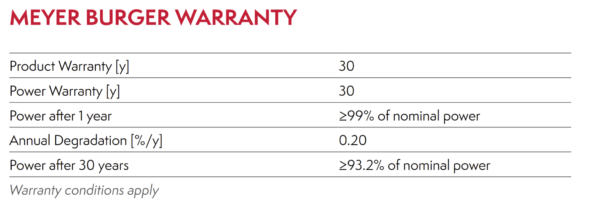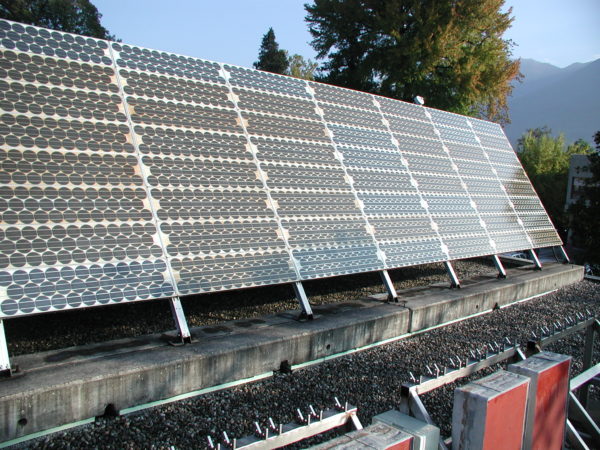Solar modules that last 50 years with very little degradation will significantly increase the value of solar power projects.
In an example, below, we see how the discounted cash flow from a project’s electricity generation increases by 46% when shifting the project from today’s standard 25-year lifetime to a 50-year time scale.
This low degradation value results from the near perfect seal that a pure glass-glass encapsulated solar panel offers compared to a standard glass-plastic backsheet product.
The future is now
We will have solar panels that are guaranteed to last 50 years with little degradation. In fact, these panels are likely being installed right now.
In recent conversations with Meyer Burger’s CEO, Erfurt Gunter, it was mentioned that the company’s glass-glass bifacial solar panel showed virtually no degradation during its durability testing. But a number had to be chosen for the warranty, so the company’s power production warranty states that Meyer Burger will replace the solar panel if its generation falls below 93.2% of its original capacity after 30 years.

What might that panel look like in 2071?
The U.S. Department of Energy funded 50-year glass-glass solar panel research in 2018, and recently funded two projects looking at inverter failure and operations and maintenance as plants reach the half century mark.
The program, Towards50, is led by Dr. Roger French. French has been publishing papers on this research, and told pv magazine USA that degradation levels below 0.2% per year suggest that the possibility of 50-year solar panels is very real. (We will cover these papers in depth in later articles.)
Running the numbers
Investors pay for the “net present value” of full earnings, minus all costs, subtracting an estimation of figure interest rates from those earnings. The point to remember is that investors pay for this value at the moment they buy the asset, decades before that cash arrives.
Thus, when calculating the discounted cash flow of a solar power project, this value can be predicted and sold. In our case, a solar power project that generates 1,000,000 kWh per year of electricity that is sold at 4 cents/kWh with a 2% electricity inflation rate, generates a discounted cash flow of $677,357 in the project’s first 25 years.
If the site were to continue running for another 25 years, that would add $316,357 in discounted electricity revenue to the value of the project.
This represents a 46.8% increase over the first 25 years of the project. A substantial fraction of this money would be paid to the solar developer when construction is complete.

There will be arguments from investors on what discount rate should be used, and what should be paid for the project’s net present value, as we attempt to forecast several decades into the future of a complex world.
However, an electricity inflation clause which protects investor revenue can be added to any solar power purchase agreement. This clause also protects the energy buyer’s savings by guaranteeing that the inflation is always lower than actual electricity inflation.

There are multiple indications that investors are already banking on 50-year timeframes for solar power projects.
A power grid interconnection’s value goes far beyond the current 25 year lifetime of solar panels – in fact – the value goes on in perpetuity.
This was recently shown when a Portuguese renewable auction drew record low bids. Local commentators suggested that the reason the bid price was below the hard costs of a solar power project was that while the electricity contract was short – 15 years – the land and interconnection rights were indefinitely long. Investors clearly were betting that they could make up for their low bid prices over the long term.
Bloomberg New Energy Finance’s Jenny Chase has likened the value of an interconnection on the power grid to “gold dust” sprinkled atop the value of a solar power plant’s original power purchase agreement.
This author has seen long term solar land lease agreements offered to Midwest farmers with 25-year contracts, including a developer’s option on a second 25-year extension of the original land lease period. Most other electricity generation assets have 40-year lifetimes and longer. And nuclear power plants in the U.S. are now seeking the opportunity to run for 80 years.
So, what will you be doing in 2071?
This content is protected by copyright and may not be reused. If you want to cooperate with us and would like to reuse some of our content, please contact: editors@pv-magazine.com.








I suppose in parts of the USA where there has been so little penetration of solar pv into the grid, making an assumption that electricity prices would rise by 2% pa is understandable. However experience in markets where there are much larger penetration of solar pv, both grid and rooftop, has shown that there have been significant price deflation in the first five years after installation of many of the grid scale solar pv systems.
The best example of this is none other than South Australia, which is the largest GW scale grid which can at time meet all its demand from solar alone. Indeed this grid has gone very close to meeting all of its demand from rooftop solar alone! There are other times when this grid meets all of its demand through wind and solar. This grid frequently sees solar and wind farms turning off their generation due to an over supply of generation, or a lack of demand in the grid, which sends the wholesale spot prices negative. In these situations the solar farms receive no revenue.
In the future this grid will see increased transmission capacity to other markets (states), increased battery storage and increased demand from hydrogen generation projects. What is not clear is how much this increased demand will match the increase in supply from additional rooftop solar and wind farms.